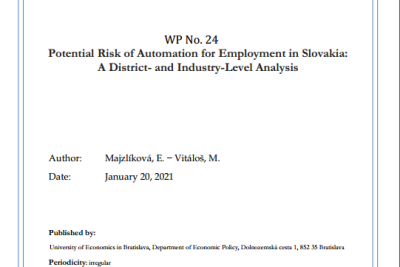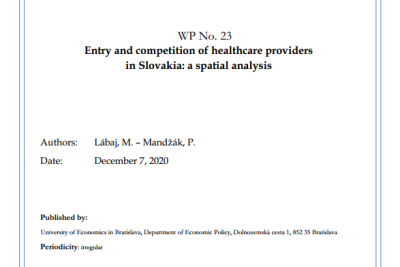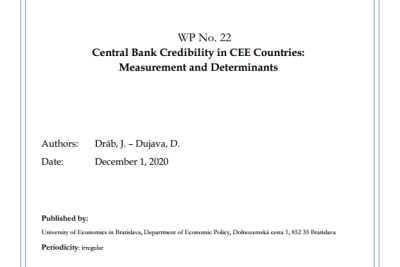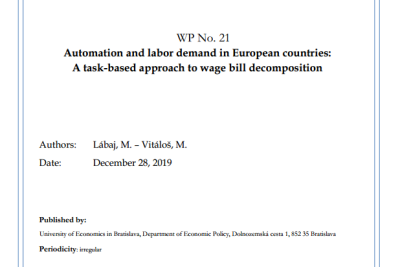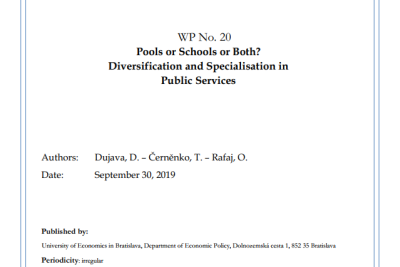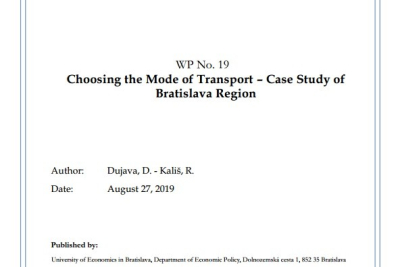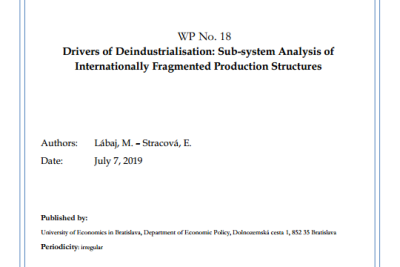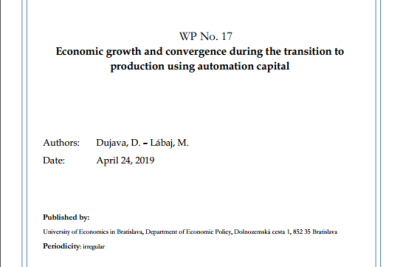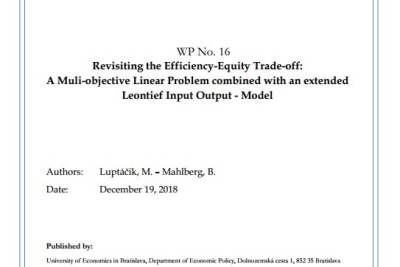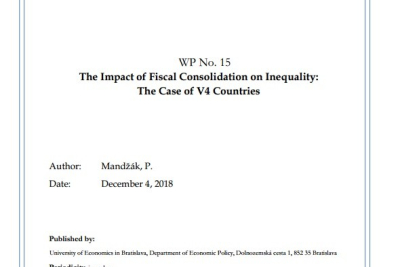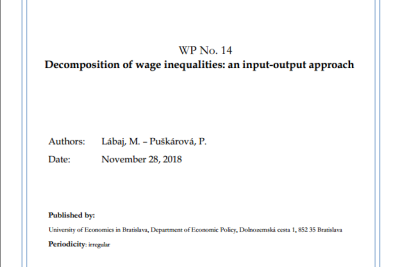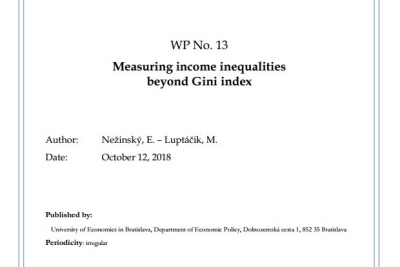Abstract
The aim of this paper is to examine the potential impacts of automation and digitalisation on the Slovak labour market, which, according to several studies, belongs to a group of countries with the highest risk. To quantify the share of employment at a high risk of automation, we use detailed employment data and automatability estimates (or substitutional potentials) for individual occupations according to three different methodologies: by Frey and Osborne (2013), Dengler and Matthes (2018), and Mihaylov and Tijdens (2019). In 2019, depending on the approach taken, the share of employment in Slovakia at a high risk of automation ranged from about 20 to 47%. Districts at the highest risk of automation include Kysucké Nové Mesto, Bytča, Myjava, Skalica and Krupina, while districts with the lowest share of employment at risk are Svidník, Levoča, Ružomberok, Košice I and Trebišov. A key point is that technological progress is not likely to increase the existing regional differences in Slovakia or have a greater impact on districts with high unemployment. Other findings show that employees with a lower income face a higher risk of losing their job as a result of technological progress. Industries with the largest share of employment at a very high risk include many manufacturing industries, as well as wholesale and retail trade. In terms of occupations, mechanical machinery assemblers and electrical equipment assemblers face the highest risk. Regarding trade, occupations potentially facing a high risk include shop sales assistants, cashiers, ticket clerks, commercial sales representatives, and stock clerks.
- Návštevy: 955
Abstract
We study the relationship between market size and a number of firms in several healthcare professions in Slovakia to provide a new evidence about
their entry decisions and a toughness of competition in the market. The size of a local market to support the entry of the first general practitioner
is estimated to 1400 inhabitants. It equals 1700 inhabitants for the first pharmacy to enter, and 2300 for pediatricians. The population has to more
than double for the second professional to enter. To support the second firm, the population per firm in the market has to increase by 30 % for pharmacies, by 25 % for general practitioners, and by almost 40 % for pediatricians. However, after the entry of the second firm, the intensity
of competition does not change, except for pediatricians. The results are robust to spatial interactions taken into account. However, our estimates of
spatial interactions show negative (but decreasing) spatial spillover effects for pharmacies, general practitioners, and dentists between 1995 and 2010. In
this period, competitive effects prevailed and outweighed demand spillovers. We document that demand effect continued to grow since 2010 and in 2017
outweighed the competition effect for pharmacies.
- Návštevy: 898
Abstract
We use three different indicators based on inflation expectations to measure central bank credibility in 9 countries in Central and Eastern Europe. We quantify credibility using differences between official inflation targets and inflation expectations as well as differences between inflation expectations and implicit targets based on estimation of the Taylor rule. Determinants of central bank credibility are investigated using pooled OLS. According to our results, stable and low inflation and sound public finances are conductive to central bank credibility. We show that our results are in line with survey-based measures of trust in local currency.
- Návštevy: 992
Abstract
To understand the effects of automation and other types of technological changes on European labor demand, we use a framework and empirical decomposition of observed changes in the total wage bill in the economy developed by Acemoglu and Restrepo (2019). The decomposition is derived from a task-based model that allows us to study the effects of different technologies on labor demand. At the center of the framework is the task content of production|measuring the allocation of tasks to factors of production. Automation, by creating a displacement effect, shifts the task content of production against labor, while the introduction of new tasks in which labor has a comparative advantage improves it via the reinstatement effect. Overall effects are country-time specific and call for an empirical exploration. We apply the decomposition to 15 European countries with good data coverage in EU KLEMS database.
- Návštevy: 245
Abstract
We develop a model of two municipalities providing two public services. We show that in case of intermediate level of transferability of public services between two municipalities, Pareto-suboptimal Nash equilibrium exists. In this case, cooperation between municipalities or merging of two municipalities into one unit would improve welfare.
- Návštevy: 189
Abstract
We analyse commuting patterns in Bratislava’s fast growing sub-urban region with suboptimal developed infrastructure. Standardized discrete choice model is used to estimate demand for individual car transport as well as for public buses and trains and to obtain corresponding elasticities with respect to travel costs, times and income. We find low rate of substitution between available modes. Direct price elasticity for public modes is in accordance with often cited rule of thumb -0.3. Negative income elasticities of demand for buses and trains, together with low direct price elasticity for car transport can be hard to overcome when looking for solution of current traffic problems in the region. We use modelled demand to predict effects of two recently proposed policies - new parking system in Bratislava city and construction of highway D4R7. In case of first policy, we expect massive reduction in car usage due to increased costs for car commuters. On the other hand, new highway would have only limited impact on mode choice and could reduce number of train commuters.
- Návštevy: 225
Abstract
This paper deals with the drivers of deindustrialisation in major developed countries over the last two decades. In contrast to some recent studies, we show that the importance of manufacturing for the world economy has not declined during the examined period. We argue that the observed deindustrialisation measured by direct employment and value-added shares of manufacturing underestimates the importance of manufacturing. Many former in-house activities of manufacturing are nowadays outsourced to other industries and are not accounted for in the direct statistics. We show that at least in major developed countries the level of outsourcing reached its limits at the beginning of the new millennium. At the same time, the offshoring of activities interlinked with manufacturing became the dominant driver of deindustrialisation in these countries. We are the first to study the importance of manufacturing from a truly global perspective and we use final consumption expenditures approach that allows us to consistently analyse the role of i) outsourcing, ii) offshoring and iii) changes in final demand, in its development.
- Návštevy: 191
Abstract
This paper examines the implications of automation capital in a Solow growth model with two types of labour. We study the transition from standard production to production using automation capital which substitutes low-skilled workers. We assume that despite advances in technology, AI and machine learning, certain tasks can be performed only by high-skilled labour and are not automatable. We show that under these assumptions, automation capital does not generate endogenous growth without technological progress. However, assuming presence of technological progress augmenting both effective number of workers and effective number of industrial robots, automation increases rate of long-run growth. We analyse a situation in which some countries do not use robots at all and other group of countries starts the transition to the economy where industrial robots replace low-skilled labour. We show that this has potential non-linear effects on σ-convergence and that the model is consistent with temporary divergence of incomes per capita. We derive a set of estimable equations that allows us to test the hypotheses in a Mankiw-Romer-Weil framework.
- Návštevy: 237
Abstract
In recent years there has been increasing interest in the question of how inequality affects economic growth. This growing interest has recently stimulated new theoretical as well as empirical research. Some existing theoretical models propose income inequality is detrimental to growth, but alternative theoretical models point at inequality as a determinant furthering economic growth. The main goal of this paper is to obtain deeper insights into the so-called efficiency-equity trade-off. Recently the Stiglitz-Report (Stiglitz et al., 2010) revealed several limits of GDP as an indicator of economic performance and social progress and recommended to shift emphasis towards measuring people's well-being. Following this recommendation, we develop a new multiple criteria decision making model coupled with an extended Leontief input-output model taking into account the social dimension and obtain deeper insights into the so-called efficiency-equity trade-off.
- Návštevy: 226
Abstract
The aim of this paper is to provide the first empirical evidence of the impact of fiscal consolidation on income inequality in V4 countries. Although the literature on income inequality and its various determinants is wide, there are still some areas in this topic, where the research is lacking. Different specifications of models imply that fiscal consolidation in V4 countries leads to an increase in income inequality. Results of our analysis suggest, that fiscal consolidation larger than 2 % of GDP has negative impact on equality in V4 countries, while this effect is stronger than the effects of our control variables { GDP growth, change in total factor productivity (TFP), change in trade openness, mean years of schooling and unemployment. Change in structural balance seems to have no effect on income inequality in the given countries. However, structural balance have surprisingly negative effect. We believe it is due to the structure of our data set, which contains only three observations with positive structural balance.
- Návštevy: 408
Abstract
Income and wealth inequalities, both between and within the advanced and developing countries, have attracted much attention in current economic debates. Wage inequalities appear to play a key role in the generation of final inequalities in terms of households’ income, consumption and wealth. In this paper, we propose a decomposition approach based on the input-output analysis that allows us to disentangle the effects on the final inequalities’ levels into the contributions of various determinants. So far, the analysis of income and wealth inequalities measured by standard inequality indices, e.g. Gini coefficient, Theil index, has received limited space in the input-output analysis. This does not imply that issues of income and wealth inequalities have been ignored in this stream of research. The focus of the input-output research has however been directed into distinct aspects of inequalities. In one way, researchers have put a lot of effort in the understanding how the income and wealth inequalities influence the structure of final demand of households, and eventually generate ambivalent effects on production, value added and employment. Other stream of research in input-output analysis has paid a lot of attention to inequalities that arise from the distribution of income that goes to labour and capital. We propose to calculate cross-industry and cross-country wage inequalities directly from the input-output tables and analyse the final inequality variations through the lens of changes in the inputs. Detailed industry-level data on employees’ wages linked to their hours worked and education attainments, which are covered by the World input-output database, allow us to illustrate the application of proposed methodology on major advanced and developing countries in the world. The analysis contributes to solving the puzzle around the impacts of human capital and technological progress on income inequality but may shed also more light on the rising global inequalities unfolded by international trade and fragmentation of global value chains.
- Návštevy: 367
Abstract
Growing interest in the analysis of interrelationships between income distribution and economic growth has recently stimulated new theoretical as well as empirical research. Since existing theoretical models propose inequality is detrimental to growth, while others point at income inequality as an essential determinant supporting economic growth. Measures such as head-count ratio for poverty index or widely used Gini coefficient are aggregated indicators without deeper insight into income distribution among the poor or the households. To derive an indicator accounting for income distribution among the income groups, we propose output oriented DEA model with inputs equal unit and weights restrictions imposed so as to favour higher income share in lower quantiles. We demonstrate the merit of this approach on the quintile income breakdown data of the European countries. Prioritizing lower income groups´ welfare, countries – e.g. Slovenia and Slovakia – can be equally favoured by the new proposed indicator while assessed differently by Gini index. Intertemporal analysis reveals a slight deterioration of income distribution over the period of 2007 – 2017 in a Rawlsian sense.
- Návštevy: 493
Strategický partner
Hlavní partneri
Partneri
